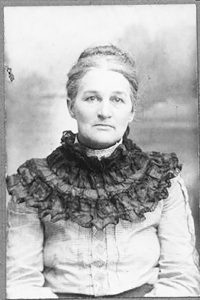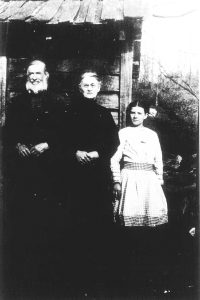Judith Ann Elizabeth Turner was born on the 22nd of March 1857 to Jefferson Turner and Susan Shortt of Floyd County. Jefferson and Susan had four children, John Francis, born in 1850, William Richard, born in 1854, Judith Ann, and Sarah Rebecca, born in 1861. Sadly, William Richard and Sarah Rebecca each only lived one year.

War came to the mountains and Jefferson enlisted with the 54th Virginia Infantry, Company H on October 1st, 1861. In early 1862, he was listed as sick at Prestonsburg, Kentucky and Jefferson succumbed to pneumonia in Abingdon on the 2nd of April 1862. Susan loaded up the wagon, went to Abingdon, and brought her husband’s body back to Shooting Creek where 32-year-old Jefferson Turner was buried at the Samuel P. Rakes Cemetery.
My grandmother had saved a newspaper clipping about Judith’s 100th birthday celebration in 1957 and thankfully, Mama had kept all her clippings. Judith recalled what life was like after losing her father at the tender age of five years old, “I was too young to work in the fields, so I stayed in the house doing the cooking and housework. Even when I wasn’t cooking, I kept a fire going in the cookstove. The smoke warned raiders that the house was occupied. When raiders did come in, I hid under the floorboards of the house.”
On September 5th, 1872, 15-year-old Judith married Isaac Alexander Nolen, a schoolteacher and Confederate veteran. Isaac had fought with the 51st Virginia Infantry and was 17 years older than his new bride. Judith recounted the events of her wedding day, “I was married at home in a white polonaise style dress which was very stylish in that day. I wore a wreath of orange blossoms in my hair.”
According to Google, “1870s and 1880s ‘polonaise’ dresses were bustle dresses with the bodice and bustling overskirt cut in one, and the bustling overskirt opening over the (often contrasting) underskirt in a V, inspired by 18th century dresses which opened over petticoats.”
After the wedding ceremony, the newlyweds and their attendants, six bridesmaids and six ushers, rode horseback from her home in Shooting Creek to his parent’s home in Elamsville, where a large reception was held. Judith stated that, “the roads were so rough that to travel by buggy was too dangerous.”
Judith and Isaac’s first child, Lillie Alice was born the following year in 1873, followed by Samuel Kemper in 1875, Isaac Edward in 1877, Susanna Mae in 1879, Minnie in 1881, Nannie in 1883, Charles Jefferson in 1885, Posey Lester in 1888, George Ross in 1891, and John Abe Nolen in 1893.

Judith and Isaac’s daughter, Susanna Mae married Thomas Jefferson Turner and their daughter, Bertie Lou Turner Ingram shared many memories of her beloved grandmother, Judith Turner Nolen. The following are Bertie’s words, “Grandma made her own yarns and dyed them, then cut and made garments for her family. She had ten children, four girls and six boys. She spun and wove the materials for suits for her husband as well as the children, made carpets and rugs from worn out clothing, and used bolting silk to dress up her living room mantle, center table and wherever linen were used. This bolting silk came from grandpa’s mill and was made into yoyos, alternating pink and natural or white. Her scatter rugs protected the woven hit-or-miss carpet that covered the living room or “parlor”. These scatter rugs were made from burlap bags which were washed, hemmed, and covered with bright woolen flowers cut on the bias and the edges fringed. They looked very pretty and protected the carpet as well. The dye that was used was made from roots, bark, leaves, walnut hulls, onion skins, fruits, and berries. Necessity being the motivating force, there was no end to the variety of products to tempt the imagination and many different colors were produced by re-dying a different shade over the first color. Blue resulted from the use of horsebrier and when used over the brown made with walnut shells, a black resulted. The dye had to be extracted first by boiling in a large vessel of water, strained and a mordant was used to set the color; salt, alum, oak balls, and copper were the most used and those who were fortunate to have materials so dyed can be assured that loving hands gave of their best and many of such is finding its way into museums where they will be heirlooms for future descendants, preserved and admired for ages to come.”
One of the first modern conveniences that Judith got was a sewing machine, the only one in the community. Girls from miles around brought their best dresses to her to be “machine stitched.” Judith was a fine horsewoman and loved high spirited horses; she recalled riding 15 miles many times with a baby in her lap.
Isaac Alexander Nolen passed away in 1923 at the age of 82. Judith remained independent and on her own until her 99th year, when she moved in with her daughter, Susanna. Judith continued to take great pleasure tending to her chickens, rabbits, and her dog and in her 100th year, she cut and sewed a dress for herself. Judith lived until the 25th of September 1960, passing away at 103 years old.
Thank you so much to George and Sheila Turner for their assistance in this story. Woody may be reached at rockcastlecreek1@gmail.com or (276) 692-9626.



